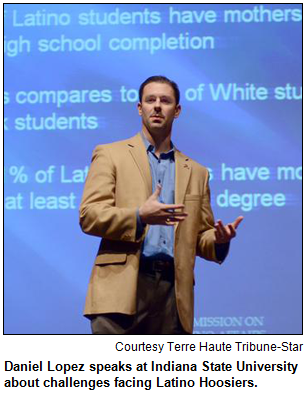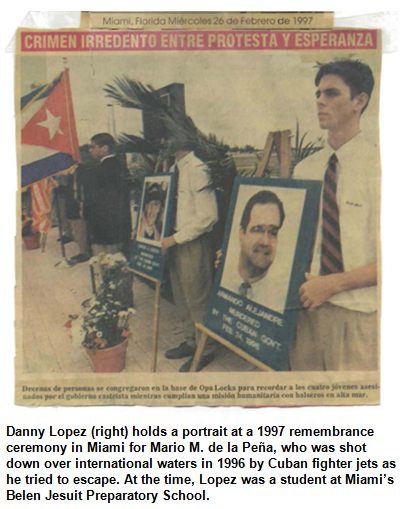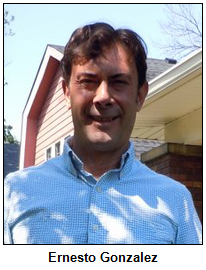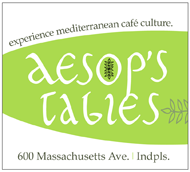You can listen to Hoosier History Live! live on the air each Saturday, or listen online at the WICR website during the broadcast on any computer with speakers, anywhere, or on a smartphone. We invite you to visit our website!
May 26 show
Cuban immigration to Indiana
Not only does our upcoming guest Danny Lopez have perspectives to share on the topic of Cuban heritage - all four of his grandparents left their homeland in 1960, fleeing political and economic upheavals - he also has broader insights about Hispanic and Latino demographics. He's the executive director of the Indiana Commission on Hispanic/Latino Affairs.
So Danny will join Nelson in studio for the next show in our rotating series about ethnic immigration to the Hoosier state. Hoosier History Live! has explored our German, Irish, Italian, Greek, Scottish, Brazilian and even our Sikh heritage in Indiana.
 Referring to 2010 U.S. Census data, Danny notes that the number of Hoosiers with Hispanic/Latino heritage nearly has doubled since the turn of the new century, climbing to 389,000.
Referring to 2010 U.S. Census data, Danny notes that the number of Hoosiers with Hispanic/Latino heritage nearly has doubled since the turn of the new century, climbing to 389,000.
About 85 percent are of Mexican heritage. The next largest ethnic groups of Hispanic/Latino heritage in Indiana, according to Danny, are Puerto Ricans, followed by Cubans.
Unlike surrounding Midwestern states that have experienced only slight population increases or, in the case of Michigan, even lost residents since the turn of the 21st century, Indiana's population climbed 6.6 percent. According to an Indianapolis Star analysis of 2010 U.S. Census data, Hispanics accounted for 43 percent of the population increase in the Hoosier state.
Cuban-Americans here (there are 4,300 of them, Danny Lopez reports) differ from their counterparts from other Latin homelands in several ways.
According to Danny, the largest concentrations of the 4,300 people of Cuban heritage live in South Bend and Fort Wayne. He attributes that to the impact for several generations drawn by, respectively, the University of Notre Dame as well as by Catholic parishes that have assisted Cuban families, including children in the early 1960s, who were evacuated because of the Fidel Castro regime.
Regarding the overall Hispanic/Latino population, though, the largest concentrations are in Indianapolis and Lake County. The average age of Hoosiers of Hispanic/Latino heritage is younger than those of many other ethnic immigration groups here, Danny notes.
Danny has been a Hoosier since 2008. He grew up in Miami and graduated from an all-male, Jesuit-run preparatory school there that had been attended by his ancestors in Havana. Jesuit priests re-established the school in Miami after Castro (despite being an alumnus himself) shut it down and converted the building into an armory, according to Danny.
With his wife, who also is Cuban-American and working on a graduate degree at IU, Danny lives in Bloomington. He commutes to Indy for his job with state government, where he also is the education director for the Indiana Civil Rights Commission. Previously, Danny spent two years as a top staff member with Bloomington Mayor Mark Kruzan.
 His wife's grandfather graduated from Notre Dame. Danny's paternal grandfather attended his alma mater, the all-male, Jesuit-run prep school, but it had a different setting then. The prep school was based in Havana (not Miami) during his grandfather’s era.
His wife's grandfather graduated from Notre Dame. Danny's paternal grandfather attended his alma mater, the all-male, Jesuit-run prep school, but it had a different setting then. The prep school was based in Havana (not Miami) during his grandfather’s era.
With increasing waves of Hispanic/Latino immigration to Indiana and other states, concerns have been expressed about "linguistically challenged" children in schools. In some immigrant households, as Danny notes, young children are the only English speakers among the family members.
But Danny also emphasizes that a reverse effect has the potential for unnecessarily limiting the advancement and talents of Hispanic and Latino children.
"We have concerns that many Hispanic families are not encouraging their kids to develop, or even keep, their fluency in Spanish," he said. "The parents want their children to assimilate so badly that they are discouraging their Spanish language usage. Obviously, though, fluency in Spanish will be a tremendous asset for professional opportunities later in life."
Another issue concerns the terms "Hispanic" and "Latino." Although often used interchangeably, the terms actually have different meanings and connotations with various ethnic heritage groups, an issue discussed last June on Hoosier History Live! during our show about Brazilian immigration. Nelson plans to have Danny share his insights on this topic, which has affected the way people have described themselves on census forms.
"Learn more" web links:
- Here is a video of an interview with guest Danny Lopez on Newsmakers from WNIN in Evansville, Ind., about Hispanic and Latino affairs.
- Here is an article from the Miami Herald about "Operation Peter Pan" or "Pedro Pan." From 1960 to 1962, about 14,000 Cuban children were flown to Miami as refugees without their parents because their parents feared for their safety under Castro.
- Here is a CNBC video about the Pedro Pan airlift with some great historic footage of the children in the early 1960s and their reunion some 50 years later.
- Here is a report from the Kelley School of Business about Indiana's Latino population.
History Mystery
During the 1990s, a city in Indiana elected a Hispanic mayor, one of the first in the state. He won two terms in office as mayor of the Hoosier city, serving from 1996 to 2003. A Democrat, he is the son of Spanish immigrants and was just 35 years old when he first won election as mayor of the city, which has been gaining population for several years. During his second term in city hall - in 2002 - the mayor launched an unsuccessful campaign for Indiana secretary of state.
Question: Name the city in Indiana that had a two-term mayor of Hispanic heritage beginning in 1996.
To win the prize, you must call in with the correct answer during the live show and be willing to be placed on the air. Please do not call if you have won a prize from any WICR show during the last two months. The call-in number is (317) 788-3314, and please do not call until you hear Nelson pose the question on the air.
This week's prize is a pair of tickets to Conner Prairie Interactive History Park, courtesy of Conner Prairie, as well as a one night stay at Residence Inn by Marriott in downtown Indianapolis on the canal, courtesy of the ICVA.
Guest Roadtripper: Ernesto Gonzalez
As Roadtripper Chris Gahl of the ICVA is playing host to visiting VIPs this race weekend, we thought we'd take the opportunity to have Cuban-born Indy resident Ernesto Gonzalez fill in for Chris with a report on the Latin and salsa dance scene in Indy, be it the Jazz Kitchen, the Red Room, or ... well, Ernesto is an active dancer and will have to tell us.
 Ernesto came to Indy in 1980 as a 17-year-old, being sponsored by the Indiana Catholic Conference at 1400 N. Meridian St. in downtown Indianapolis.
Ernesto came to Indy in 1980 as a 17-year-old, being sponsored by the Indiana Catholic Conference at 1400 N. Meridian St. in downtown Indianapolis.
"I came as a political refugee, completely by myself, speaking no English, with only the clothes on my back," he says.
Ernesto has worked in Indianapolis as a hair designer for 32 years.
"America provides opportunities," he says. "I believe in hard work, and in reaping the rewards of hard work. I also believe that it is very important for everyone coming to this country to learn English."
Ernesto's parents and three siblings still live in Cuba, and 15 years ago Ernesto sponsored one of his brothers in moving to Indianapolis.
Indy 500 special!
Audio treat for race history fans online
 As a special Indy 500 treat for our listeners, we have published audio of the Hoosier History Live! interview with Indianapolis Motor Speedway historian Donald Davidson from our March 5, 2011 show.
As a special Indy 500 treat for our listeners, we have published audio of the Hoosier History Live! interview with Indianapolis Motor Speedway historian Donald Davidson from our March 5, 2011 show.
It's also on our Facebook page and on the "Listen" page of the Hoosier History Live! website.
Be sure to "Like" us on Facebook, and please consider supporting the show financially so we can bring you more.
Your Hoosier History Live! team,
Nelson Price, host and creative director
Molly Head, producer, (317) 927-9101
Chris Gahl, Roadtripper
Richard Sullivan, webmaster and tech director
Pam Fraizer, graphic designer
Garry Chilluffo, creative consultant
Michele Goodrich, Jed Duvall, grant consultants
Joan Hostetler, photo historian
Dana Waddell, volunteer-at-large
www.hoosierhistorylive.org





Please tell our sponsors that you appreciate their support: Aesop's Tables | Just Fine the Way They Are, a children’s book about the National Road | Indiana Historical Society | Lucas Oil | Story Inn.
 Acknowledgments to Print Resources, Indianapolis Marion County Public Library, Monomedia, Indiana Humanities, Indianapolis Convention & Visitors Association, WICR-FM, Fraizer Designs, Heritage Photo and Research Services, Derrick Lowhorn, Samantha Stratton and many other individuals and organizations. We are an independently produced program and are self-supporting through organizational sponsorships, grants and through individual tax-deductible contributions through the Indiana Humanities Council. Visit our website to learn how you can support us financially.
Acknowledgments to Print Resources, Indianapolis Marion County Public Library, Monomedia, Indiana Humanities, Indianapolis Convention & Visitors Association, WICR-FM, Fraizer Designs, Heritage Photo and Research Services, Derrick Lowhorn, Samantha Stratton and many other individuals and organizations. We are an independently produced program and are self-supporting through organizational sponsorships, grants and through individual tax-deductible contributions through the Indiana Humanities Council. Visit our website to learn how you can support us financially.
June 2 show
Brain chemistry and genetics studies in mental illness, addictions
Folks who don't regard Indiana as cutting-edge may be surprised to learn that, beginning about 120 years ago, Hoosier researchers were pioneers in brain studies to help the mentally ill.
 The research, which eventually included the biological aspects of addictions, had its beginnings in a two-story, brick building known as the Pathology Department on the grounds of what was then called the Central Indiana Hospital for the Insane (later Central State Hospital) on the near-westside of Indy.
The research, which eventually included the biological aspects of addictions, had its beginnings in a two-story, brick building known as the Pathology Department on the grounds of what was then called the Central Indiana Hospital for the Insane (later Central State Hospital) on the near-westside of Indy.
Today, the Pathology Department, which opened amid much fanfare in the 1890s, is the site of the Indiana Medical History Museum.
Studies that went on there - as well as subsequent lab work (including animal research that involved rats and pigeons) at the Institute of Psychiatric Research at the IU Medical School - were at the forefront in establishing biological influences on depression, alcoholism and other mental health issues.
The idea for the studies, regarded as "state of the art in brain science of the time," according to two psychiatrists who will join Nelson in studio, was to "use the best in science to improve the condition of the mentally ill in Indiana."
Nelson's guests will be Dr. Lucy Jane King and Dr. Alan Schmetzer, professors emeriti of psychiatry at the IU School of Medicine. They are co-authors of a new book, Dr. Edenharter's Dream (Hawthorne Publishing), which describes the decades of historic research in brain chemistry and genetics that unfolded in the Hoosier capital.
 It began, our guests note, during an era when psychiatric hospitals were derided as "insane asylums." Mental illnesses often were attributed solely to bad parenting and other "nurture" factors.
It began, our guests note, during an era when psychiatric hospitals were derided as "insane asylums." Mental illnesses often were attributed solely to bad parenting and other "nurture" factors.
Our guests credit Dr. George Edenharter (1857-1923), who oversaw the opening of the Pathology Department in 1896 as a house laboratory and teaching facility, with a "forward-thinking attitude" about the brain and genetics that kicked off decades of ground-breaking research.
Dr. King and Dr. Schmetzer trace the decades of brain and genetics research in Indiana to the studies undertaken at the Pathology Department, which had an autopsy room and labs equipped with low-level microscopes in the early 1900s.
"This was state-of-the-art at the time," Dr. King said during a recent presentation at the Indiana Medical History Museum, 3045 W. Vermont St. in Indianapolis. In their book, Dr. King and Dr. Schmetzer describe the Pathology Department as "a national model visited by psychiatrists from around the country."
© 2012 Hoosier History Live! All rights reserved.